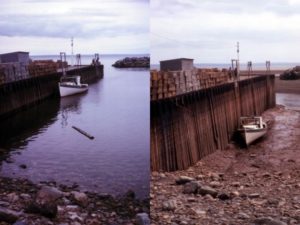Moon Power: HMMH Moves Into a New and Exciting Field
09.18.2009 | HMMH |by Steve Barrett
Tides are the rising and falling of Earth’s ocean surface caused by gravitational forces of the moon and sun. The rising and falling is most dramatic twice each month when the Sun, Earth, and Moon align in space, revealed to skygrazers as either a full or new moon.
Tides are also more pronounced at the poles than at the equator, and in jagged and irregular coastlines than straight coasts.
People have used the power of the Earth to do work for centuries. River water and the wind driving grist mills provide the most familiar examples. The power of the tides has been more difficult to harness primarily due to the vastness of the ocean. Recent advances in technology are making the conversion of tidal currents to electricity possible.
HMMH is currently working with the Town of Edgartown, Massachusetts to investigate the opportunity of extracting tidal current energy from the Muskegat Channel – located between Martha’s Vineyard and Nantucket – to provide power to the Town’s residents.
For a view of the study area, see: http://media.marine-geo.org/image/nantucket-sound-2008
A 2005 report by the Electric Power Research Institute (EPRI) on tidal energy resources identified Muskegat Channel as the best tidal energy site in Massachusetts. Because Muskegat Channel is within 3 miles of land and therefore in the legal boundaries of Edgartown, the Town decided to claim the right to evaluate the resource for energy development. In March of 2007, it was granted a Preliminary Permit from the Federal Energy Regulatory Commission (FERC), giving it exclusive development rights. Since that time, the Town has been working with researchers at the University of Massachusetts at Dartmouth’s School for Marine Science and Technology to more accurately measure and map the current velocity in Muskegat Channel to confirm the power of the resource and its capacity to generate electricity. These data, reported in July of 2009, confirmed that the power of the currents (measured in knots per second) was even better than that predicted in the 2005 EPRI Report. With this fundamental puzzle piece now placed, the next step is to prepare a project concept, undertake baseline environmental data collection, and conduct analyses of potential impacts from the project.
In anticipation of this next phase, Edgartown asked HMMH if it would lead a proposal team to bid on a solicitation from the US Department of Energy’s (DOE) Advanced Power Program to fund baseline environmental data collection and environmental impact analysis. In early June, HMMH submitted its proposal titled “Environmental Effects of Sediment Transport Alteration and Impacts on Protected Species: Edgartown Tidal Energy Project.” On September 3rd, DOE awarded grant funds to HMMH to implement the research.
HMMH’s proposal is based on the installation of a 1.5 MW pilot stage tidal energy project. The study will consider each of the two prevailing tidal energy technologies that could be used:
- horizontal open bladed turbines mounted on monopoles
- horizontal helical turbines that float from moorings
A graphic illustration of an open-bladed turbine can be viewed at: http://bit.ly/2yqd8ox
Projects for each of the two technologies have been demonstrated on the East Coast of the U.S. In the East River in New York City, Verdant Power has deployed two horizontal bladed turbines and presently has an application before FERC for a larger pilot project. Ocean Renewable Power Company (ORPC) has deployed a one-third scale model of a helical turbine in the western passage near Eastport, Maine and is currently building a full-scale model to be deployed this winter.
For the Muskegat Channel Environmental Study, the DOE is funding Woods Hole Oceanographic Institution and UMASS-Dartmouth to conduct baseline data collection to characterize the oceanographic processes and benthic habitat in Muskegat Channel, which will be used to develop a site-specific computer model for predicting changes in sediment dispersion caused by the pilot tidal project. The model will be run for both types of technologies for comparison. The Provincetown Center for Coastal Studies will be collecting all of the available existing information on marine protected species occurring in Muskegat Channel and assessing the potential impacts of the two tidal technologies on those species based on known behaviors and habitat preferences. HMMH, acting as the Town of Edgartown’s consultant, will manage and direct all research activities, interact with regulatory agencies and the public, and facilitate all project reporting. The studies will be completed over a two year period.








